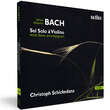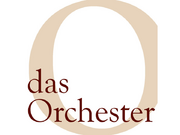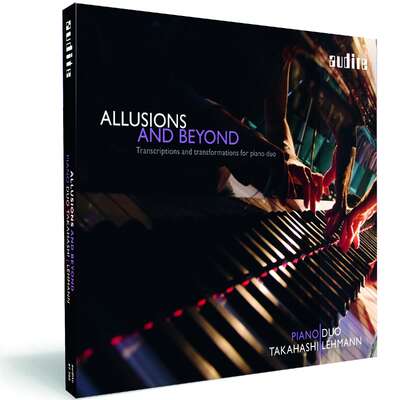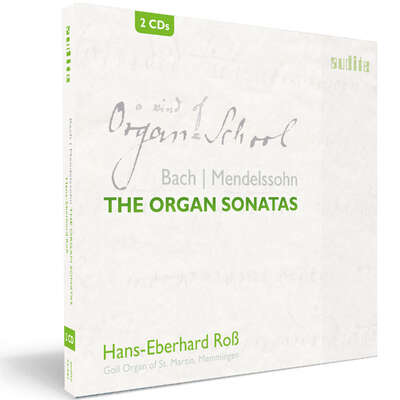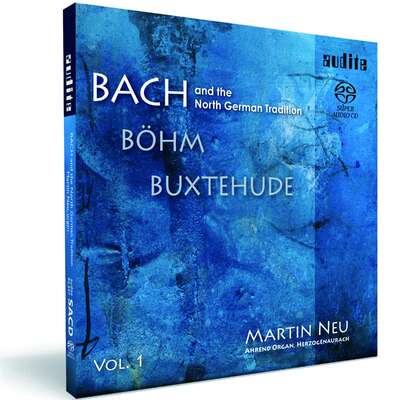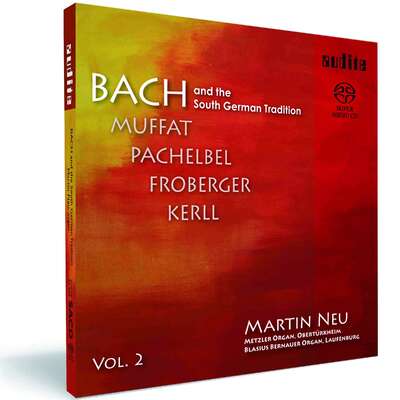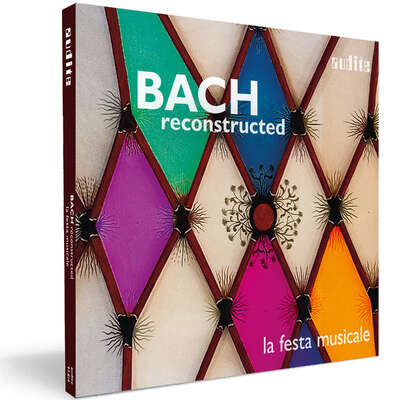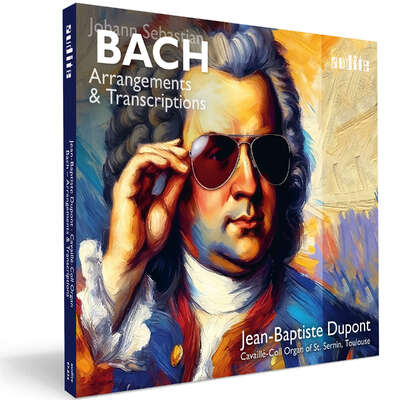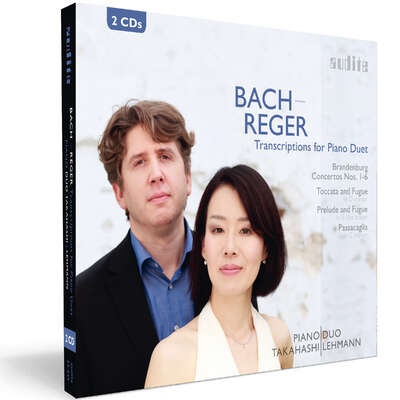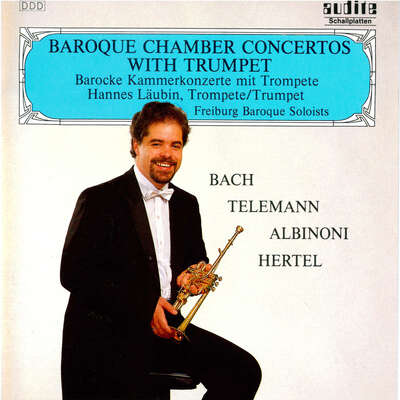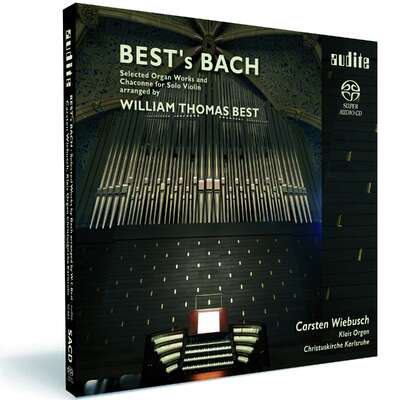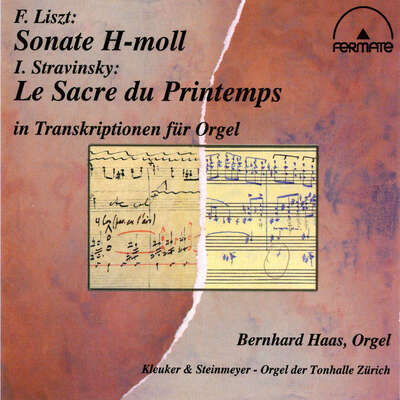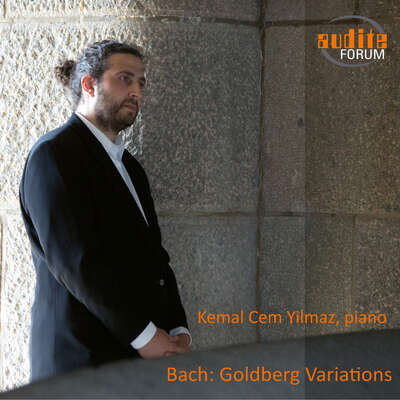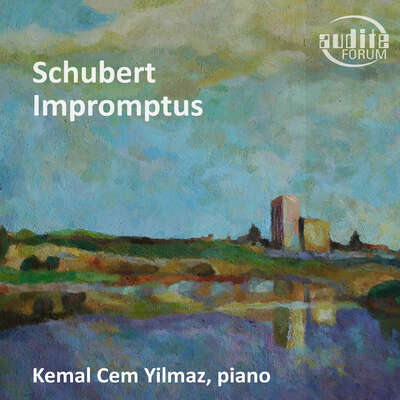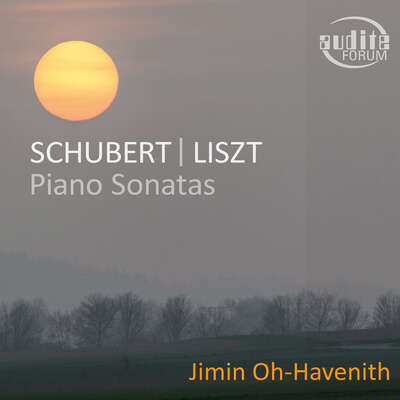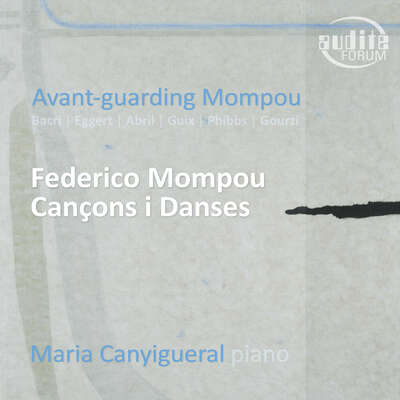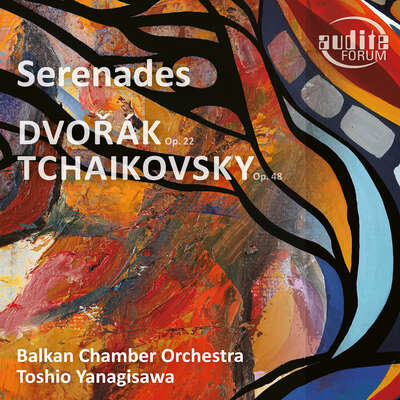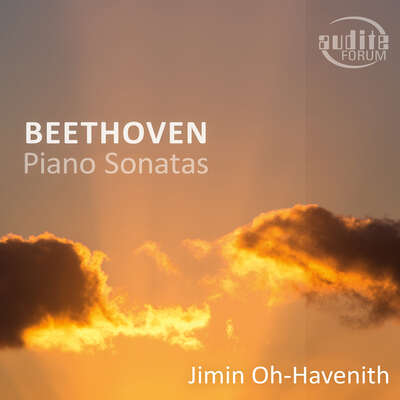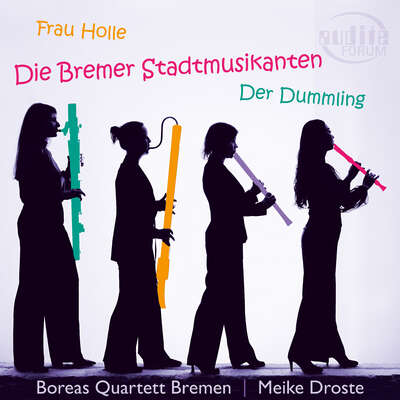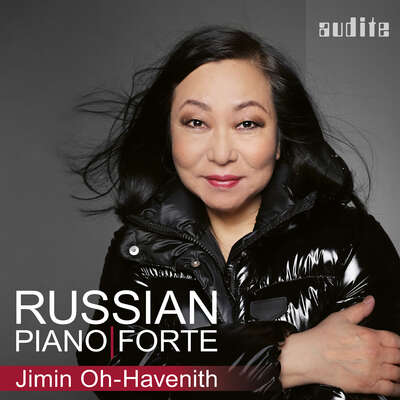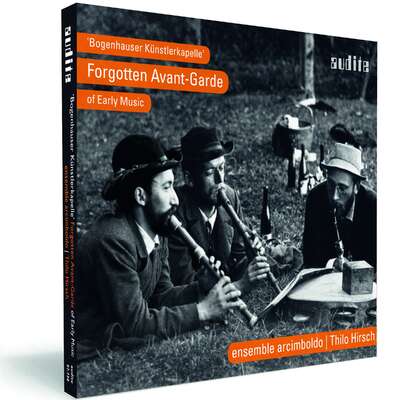
Musikalische Tiefe, perfekte Form: Bachs Sonaten und Partiten für Violine solo sind ein Wunder an Zeitlosigkeit, das viele Deutungen erlaubt. Christoph Schickedanz zeigt hier einen eigenständigen Interpretationsansatz zwischen den Polen einer „traditionellen“ und „historisierenden“ Sicht auf Bach.mehr
Musikalische Tiefe, perfekte Form: Bachs Sonaten und Partiten für Violine solo sind ein Wunder an Zeitlosigkeit, das viele Deutungen erlaubt. Christoph Schickedanz zeigt hier einen eigenständigen Interpretationsansatz zwischen den Polen einer „traditionellen“ und „historisierenden“ Sicht auf Bach.
Titelliste
Details
| Johann Sebastian Bach: Sei Solo á Violino senza Basso accompagnato | |
| Artikelnummer: | 23.434 |
|---|---|
| EAN-Code: | 4022143234346 |
| Preisgruppe: | BCE |
| Veröffentlichungsdatum: | 3. August 2018 |
| Spielzeit: | 128 min. |
Zusatzmaterial
Informationen
„Auf ein System, für ein kleines Instrument schreibt der Mann eine ganze Welt von tiefsten Gedanken und gewaltigsten Empfindungen". Diese Worte stammen von Johannes Brahms, mit größter Bewunderung sprach er über die sechs Sonaten und Partiten für Violine solo von Johann Sebastian Bach, diesem Wunder musikalischer Zeitlosigkeit und Ausdruckstiefe. Geiger begegnen dieser Musik mit Ehrfurcht, sie studieren sie ein Leben lang und haben doch immer das Gefühl, ihr niemals ganz gerecht zu werden. Sie sind die ultimative Herausforderung, eine Lebensaufgabe. Schickedanz Sicht auf diese Werke ist aus der Musizierpraxis heraus entstanden - ein eigenständiger Interpretationsansatz zwischen den Polen einer „traditionellen" und „historisierenden" Sicht auf Bach. Er sieht in der Geige ohnehin nur das Medium, für das diese Musik konzipiert wurde:„Es ist absolut nicht zwingend, dass sie nur auf einem bestimmten Instrumentarium „richtig" darzustellen ist".
Besprechungen
Fanfare | February 2019 | Robert Maxham | 1. Februar 2019
A passage in Norbert Hornig’s notes to Christoph Schickedanz’s readings of Bach’s six sonatas and partitas for solo violin may give listenersMehr lesen
Open-minded listeners, who haven’t read and pondered the booklet’s challenges, on the other hand, may find in Schickedanz’s brisk tempos (consider the First Sonata’s Fuga) and lack of sentimentality (he playfully detaches phrases in the following movement) a refreshing change from readings embodying the perverse notion that slowing down tempos to almost half the familiar speeds will yield rich insights for those listeners who remain awake. He spits out the articulation in the Second Sonata’s Corrente, reanimating a dance that might otherwise have sounded flat-footed—but still slyly realizes all Bach’s subtly implied harmonies. The skittish double of the Sarabande could offer to skeptics a sort of apologia of Schickedanz’s heady manner, which some listeners may nevertheless consider non-reverential (but not, even in the extreme case, irreverent). His approach turns to the darker side in the second sonata’s Grave, but he recovers his bright sparkle in the Fuga that follows. Here, as in the First Sonata’s corresponding movement, Schickedanz combines logic with and resonance to achieve a winning effect—and create an enduring impression. In a similar way in the Andante, Schickedanz combines a sharply pointed accompaniment with a discreetly, but effectively, ornamented melody. Schickedanz dices the phrases of the second partita’s Allemande—curious listeners can find this procedure explicitly marked out in the second (illustrative) volume of Carl Flesch’s comprehensive treatise on the art of violin playing.
It appears, then, that Schickedanz will admit influences that precede the period-instrument movement. While allowing these breath marks (of a sort) to be an influence, violinists could nevertheless follow them more covertly. Perhaps it will become HIP, or even hip, to do so in the future. In any case, Schickedanz takes repeats, as in the Sarabanda, as an opportunity to insert his own two-cents’ worth of ornamentation—many may find that it’s worth infinitely more. His reading of the Chaconne lasts only 12:55, channeling the spirit of Heifetz rather than that of Szigeti, at least in the sense that he doesn’t purport to commune with the infinite by taking infinite time. (Still, there’s a powerful authority in Heifetz’s playing that should be evident even to those put off by his manner.) The same’s true of the first movement of the Third Sonata, which doesn’t appear in Schickedanz’s reading as such a leaden slog as it can be. The Fugue comes across with a similar vibrancy that depends—but not entirely—on the lively tempos he has chosen. Still, some listeners may miss the sweep that Milstein brought to the statements of the theme in double-stops during the episodes. The same is true in the finale, which, concerto-like as Schickedanz makes it, may not strike listeners as so majestic as Milstein’s. At 3:26, Schickedanz doesn’t exceed any speed limits in the Third Partita’s Preludio, but he’s brilliant enough on his own terms. His occasionally tart ornamentation makes the minuets especially invigorating.
Throughout, Schickedanz plays powerfully and has been captured in a resonant acoustic ambiance by Audite’s engineers. Since I find so much to admire and so little with which to quibble in the set, I’d advise potential purchasers to listen to Schickedanz play but not to heed what he says: Don’t discard Heifetz, Milstein, Grumiaux, or Szigeti. They’re not old hat: Scholarship hasn’t superannuated them (and nothing short of the kind of computer analysis that has exposed weaknesses in even José Raul Capablanca’s chess playing ever can). But do acquire Schickedanz’s set—he’s the real thing.
I’ve lumped two sets of Bach’s solo sonatas and partitas into one review not because of their repertoire or even because of similarities in the violinists’ approaches (besides, Schickedanz plays a modern instrument, and Gottfried von der Goltz a violin made by Carlo Antonio Testore in 1720 but apparently strung up in the period way), but because of the strong whiff of condescension in the respective booklet notes of each. While Schickedanz can’t “envision” playing Bach’s music as Szeryng did, Dagmar Glüxam, in his notes to von der Goltz’s set, makes it clear that he (speaking for von der Goltz or for himself?) thinks composers like Schumann and Mendelssohn found these works “baffling” enough to feel that piano accompaniments might enhance their effect. It follows in an absurd kind of way that, with my study of sort-of-modern musicology, I have a deeper insight into Bach’s music than did one of the supreme musical geniuses of all time (Mendelssohn). History’s a whole lot, but it isn’t everything. Bach himself possessed a musical intellect that transcended time, and his output should transcend changing manners of performance and even advancing (or merely changing) scholarship (you can play Bach on kazoos—an ensemble formed to do it—or sing it—again, an ensemble made a name for itself doing just that).’s engineers. Since I find so much to admire and so little with which to quibble in the set, I’d advise potential purchasers to listen to Schickedanz play but not to heed what he says: Don’t discard Heifetz, Milstein, Grumiaux, or Szigeti. They’re not old hat: Scholarship hasn’t superannuated them (and nothing short of the kind of computer analysis that has exposed weaknesses in even José Raul Capablanca’s chess playing ever can). But do acquire Schickedanz’s set—he’s the real thing.
Von der Goltz distinguishes his performances not only by the inclusion of occasional ornaments (Schickedanz did that, too), but by a manner that I’ll characterize as “pointed”—sharp articulation with pauses enough to separate phrases slightly. This emerges more strongly perhaps in the dance movements of the partitas than in the da chiesa movements of the sonatas. (The “period” sound he draws from his instrument isn’t so nasal or so crunchy as to evoke a strong reaction.) Despite all this lively articulation, some of the dances, such as the Corrente from the First Partita, may strike some listeners as more manner than matter—more a collection of arch gestures than sustained oratory. They may find that, while Schickedanz consistently offers new things to consider, von der Goltz repackages older gifts with new paper and ribbon. There’s a sort of irony in this more pro forma reading, because the notes to von der Goltz’s recordings attempt to make a case that these works represent the entirety of the human soul. (Could the prodigiously talented Mendelssohn or the literary-poetic Schumann have been perspicacious enough to have understood this, despite their limited musicological backgrounds?)
As in the set by Schickedanz, after the darker Grave, the Fugue sounds crisp (though it seems to bog down more than Schickedanz’s in morasses of polyphonic detail. Von der Goltz doesn’t make the accompaniment to the slow movement’s melody so staccato as did Schickedanz; and his reading sounds correspondingly less piquant. Von der Goltz plays the opening movement less predictably than does Schickedanz, at least it should seem less predictable to listeners familiar with Carl Flesch’s suggestions about how to parse its phrases. The Chaconne, at 13:40 rather than Schickedanz’s 12:55, sounds a bit more relaxed and even a mite less sharply articulated—his arpeggios build arguably with a correspondingly greater sense of purpose. The first movement of his reading of the C-Major Third Sonata may not strut along so jauntily as does Schickedanz’s, but the succeeding fugue delivers its argument with an iron sense of inevitability. That sense of inevitability makes the finale especially cogent as well as brilliant. The Third Partita sounds straightforwardly brilliant, although von der Goltz’s technical command creates art concealed by art (in this case, art concealed by artifice?). Von der Goltz invests the Bourée with an irresistible rhythmic drive, contrasting it with the Gigue, during which he relaxes into a more lambent playfulness.
Despite whatever pretensions readers may find unappealing in the notes, the performances, like those by Schickedanz, speak for themselves. Recommended.
Das Orchester | 2/19 | Franzpeter Messmer | 1. Februar 2019
Neueinspielungen der Bachschen Werke für Violine solo treffen auf dieMehr lesen
American Record Guide | January / February 2019 | Joseph Magil | 1. Januar 2019
These two performers represent two different schools of baroque performance. Gottfried von der Goltz plays with a violin in baroque set-up and aMehr lesen
Between the two, I prefer Schickedanz. He is a more analytical player, and he sounds more involved in the music. The ornaments he plays are more interesting than the ones I have heard before. Both sets are good, but neither makes it onto my short list.
Goltz plays a violin made by the 18th-Century Milanese maker Paolo Antonio Testore around 1720. Schickedanz plays a violin made by Giovanni Antonio Marchi in 1780 with a bow from the Peccatte school around 1860.
Fono Forum | Januar 2019 | Norbert Hornig | 1. Januar 2019
Bachiana
Vier neue Aufnahmen der Sonaten und Partiten für Violine solo
Wenn es um die Musik von Johann Sebastian Bach geht, herrscht unter Geigern seltene Einigkeit: Die Solowerke, die Bach für ihr Instrument schrieb,Mehr lesen
Fast ausnahmslos sind alle Bach-Interpretationen jüngeren Datums von den Gestaltungsprinzipien der historischen Spielpraxis beeinflusst, mehr oder weniger. Das trifft auch auf die Darstellung von Christoph Schickedanz zu. Er verwendet modernes Instrumentarium, entsprechend vollmundig ist das Klangbild. Doch nicht nur das macht diese Aufnahme anziehend. Hinzu kommen die sprachhafte Deutlichkeit der Phrasierung, ein phänomenales, metrisch exaktes Doppelgriffspiel in den Fugen und eine adäquate Betonung des Tänzerischen. Aber auch der kontrastreiche Umgang mit Tempo und Dynamik trägt dazu bei, dass man dieser Interpretation bis zum Schluss lauschen kann, ohne zu ermüden. Die Chaconne klingt kompakt, stringent und in ihrer Gliederung glasklar. In der Summe ist hier eine Aufnahme von überzeugender Individualität entstanden.
Record Geijutsu | 2018.12 | 1. Dezember 2018
Japanische Rezension siehe PDF!Mehr lesen
Gramophone | November 2018 | Rob Cowan | 1. November 2018
Bach for Solo Violin
Rob Cowan goes beyond Hilary Hahn’s exceptional solo Bach and listens to some other recent ventures in this repertoire
[…] On the evidence of what we hear, the remaining three violinists are rather more au fait (or should I perhaps say ‘connected’?) with currentMehr lesen
The German-Norwegian violinist and conductor Gottfried von der Goltz is the best known of the group under consideration, principally for his excellent work with the Freiburg Baroque Orchestra. His approach, though consistent, is drier than either Zsigmondy or Shickedanz, the C major Sonata’s Fugue suggesting little in the way of exaltation – it does drag rather – while the D minor Chaconne is for the most part bereft of expressive vibrato, though there’s something to be said for keeping the tempo more or less steady and some of von der Goltz’s playing at speed is impressive. It’s a good set, very well recorded, but hardly the most memorable on the current market.
The least familiar name among those cited here is Mie Kobayashi, who was invited to become a jury member of the violin division of the Marguerite LongJacques Thibaud International Competition. As to her playing, there are times when she bends the line so severely that it threatens to topple over the edge. The first movement of the First Sonata is pretty slow and the Fugue courts some dynamic extremes, though it’s often quite delicate. Kobayashi will lean into a chord with a purpose, sometimes toying with subtle ritardandos. The opening Allemande of the First Partita occasionally pushes forwards, a dramatic gesture that, while momentarily effective, I wouldn’t want to encounter too often. The Corrente is choppy, like Schickedanz’s, but without the tension that he generates; nor is the presto Double as brilliant as Devy Erlih’s. […]
Audio | 10/2018 | Andreas Fritz | 1. Oktober 2018
Als das "alte Testament der Violinmusik" hat Yehudi Menuhin Bachs sechs Sonaten und Partiten für Violine solo bezeichnet: Die Werkgruppe gilt bisMehr lesen
www.pizzicato.lu | 18/08/2018 | Guy Engels | 18. August 2018 | Quelle: https://www.pizz... Die Welt auf einem Instrument
‘Sei solo a violino’ – Bachs Titel seiner Solopartiten und -Sonaten könnte man, frei aus dem Italienischen übersetzt, durchaus als DrohungMehr lesen
Nicht für Christoph Schickedanz. Er kniet sich mit Leib und Seele in diese Musik oder – um es weniger poetisch auszudrücken – er packt den Stier bei den Hörnern.
Auf Faksimile-Bildern erkennt man den kräftigen Tintenstrich, mit dem Bach die Partiten und Sonaten komponiert hat. Diesen Strich überträgt Christoph Schickedanz auf seinen Bogen, ohne jedoch das technisch Filigrane zu übertünchen. Klang und Technik gelten jedoch nichts, wenn der musikalische Gedanke fehlt. Das ist bei dieser Aufnahme deutlich spürbar nicht der Fall. Christoph Schickedanz lässt die Musik tanzen, wo Bach eine Tanzform schreibt. Er lässt sie atmen, wo die Rhetorik dies verlangt. Er spielt poetisch und einfühlsam, wenn der Spannungsbogen dies erfordert. Obwohl uns natürlich bewusst ist, dass die Aufnahme nicht in einem Take entstanden ist, bleibt es dennoch zu bewundern, wie der Violinist während über zwei Stunden Spielzeit den Spannungsbogen hochhält.
Admirably breathed and rhetoric and overall vigorous performances of Bach’s solo sonatas.
www.opusklassiek.nl | augustus 2018 | Aart van der Wal | 1. August 2018 | Quelle: https://www.opus...
Er is veel gloed en warmte, gepaard gaande met een vlekkeloze intonatie en een sterk ontwikkeld gevoel voor structuur. Wat ook treft is de zuiverheid van de fraseringen, de fraaie uitwerking van de melodielijnen en de messcherpe articulatie in de vaak lastige dubbelgrepen.Mehr lesen
